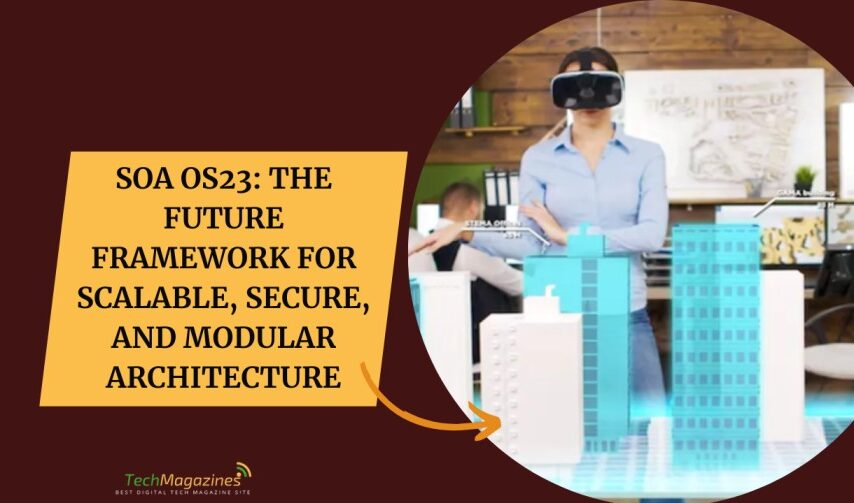In the changing world of enterprise IT, a new way of building systems is coming to life. It’s called SOA OS23. It doesn’t make noise, but it matters. It isn’t a slogan. It’s a way to bring together speed, scale, and clean design. It answers the tough questions about how systems talk to each other, how they grow, and how they keep working without breaking apart.
If you’re looking for the backbone of tomorrow’s digital world, or if you want a system that lets parts move without falling out of place, this is worth knowing. This guide will take you through what SOA OS23 is, why it matters, how it works in real life, and—most important of all—how your business can start using it now.
SOA OS23 is A New Standard for Distributed System Integration
SOA OS23 means “Service-Oriented Architecture, Operating Standard 2023.” It comes from the old ways of SOA — build once, use again, make things work together. But this one does more. It brings in:
Triggers that fire on events
- Code that runs in many tongues — Node.js, Python, Rust, Java, Go
- Old systems talking to new ones
- Identity that’s secure and owned by the user
- Messages that never trust but always verify
No single company owns it. It’s open. Made and shaped by engineers, builders, and folks who make systems play well together. This isn’t your old SOA. OS23 was made for containers, for systems that never sleep, and for messages that don’t wait in line.
Why Modern Enterprises Are Embracing SOA OS23
We don’t just build apps now. We build worlds. SOA OS23 knows this. It’s made to let anything speak to anything, no matter the language or machine.
It’s built to work across all systems, in any form
It makes small services act like they belong together
It runs out on the edge, where data meets the world
It fits together piece by piece — each part stands alone, but all parts connect
That makes it ready for what’s coming — AI, machines talking to machines, money systems that never sleep, and business tools that build themselves.
The Foundational Elements Powering SOA OS23
Decentralized Message Handling
No more middlemen. Services talk straight to each other. They keep their own logs. You can play messages back if you need to.
Modular Orchestration
Each service says what it is. It comes with its own instructions — clean and simple — in JSON, YAML, or ProtoBuf. You plug it in, and it works.
Security by Design
It’s locked down from the start. Tokens guard the gates. Every message is sealed with AES256. You can trace every call from start to finish.
Observability + Monitoring
You see what’s happening as it happens. OpenTelemetry and Prometheus are built in. No guessing. Just facts.
Fail-Safe Fallbacks + Self-Healing
When something breaks, it doesn’t stay broken. It reroutes. It heals. Services fix themselves when the rules say they must.
Industries Benefiting from SOA OS23 Architecture
Fintech Platforms
Get your services to work together. It is KYC, fraud checks and payments as one. No downtime. All loose ends. Only smooth, steady compliance.
Healthcare
Labs talk to hospitals. Insurers are talking to labs. Through clean, secure pipes all the way. Data is safe. It stays tight on identity. They are built in — the rules, HIPAA and all.
Logistics
Warehouses are in flux with the moment. Routes change. In real time devices update. It listens and moves with the work.
Data Pipelines & AI
They run models the way they should. The data flows clean. It all changes and learns, it all moves, without pause.
Government Infrastructure
National systems are strong, but they are scattered. Everything is connected, everything is safe: IDs, taxes, public records. They follow the rules. People get their work done.
How to Migrate to SOA OS23
Step 1: Perform System Audit
Write it all down. Every service. Every data flow. Every outside connection. Find the old stuff — the XML, the SOAP, the patched-together APIs.
Step 2: Implement Interoperability Adapters
Wrap the old code so it plays well with the new. Use Dapr. Use gRPC with HTTP. Whatever works. Just make it speak the right language.
Step 3: Deploy OS23 Compliance Layer
Start small. Use it on the parts you can afford to lose. Turn on the monitors. Set up the backups and failovers. Watch it work.
Step 4: Refactor Workflow Logic
Get rid of the clock. Let the system react instead of waiting. Use events. Let them drive the work.
Step 5: Train Teams & Define Governance
Teach the people. Set the rules. Define what good looks like — the uptime, the response time, the promise the system has to keep.
End-to-End Security & Governance Framework
In OS23, security isn’t bolted on. It’s baked in. You get:
- Networks that trust no one
- Tokens that change hands often
- Clear trails for every call
- Service discovery that stays locked down
Tip: Give each endpoint its own rules. No shared secrets. No shortcuts.
Advanced Deployment Scenarios Enabled by SOA OS23
Geo-Distributed Services with High Availability
Services know where they live. OS23 spreads them out — region by region. The system sends users to the nearest one. Fast. Simple. Reliable.
Real-Time Data Throughput with Event Bus Integration
It speaks Kafka. It speaks NATS. High-speed messages come in, get handled, and trigger action — all in stride.
API Evolution Management
Things change. OS23 knows. It keeps old clients working with new ideas. Versions stay clear. Adapters help the past talk to the future.
Conclusion
SOA OS23 is not another name that will disappear. This is what happens when you finally clean up the mess. Each had its place. Doing what it should in every part. They speak clearly. They do what you ask them to do. It is hard to move over. It was like chasing cats through a narrow alley. However, when it’s done, the reward is there. Crashes in the middle of the night are a thing of the past. There is no more hoping the locks hold. They work together, steady and strong like a band that knows the tune. SOA OS23 might be the grown up in the room that your systems have been waiting for in a world where every minute costs more than you want to pay.
FAQs
Q1: What makes SOA OS23 different from regular SOA?
A: SOA in general is like a flip phone, it worked, but just. The smartphone upgrade: OS23 is smarter, faster and doesn’t crash when you actually need it to work.
Q2: How long does migration take?
A: Anywhere from six months to “when will this nightmare end?”. It depends on how much legacy spaghetti code you are untangling. Buy coffee and budget accordingly.
Q3: Do I need to fire my entire IT team?
A: No, but they will need to be trained. It’s like teaching your grandparents how to use smartphones, so patience is needed, but it can be done with guidance.








